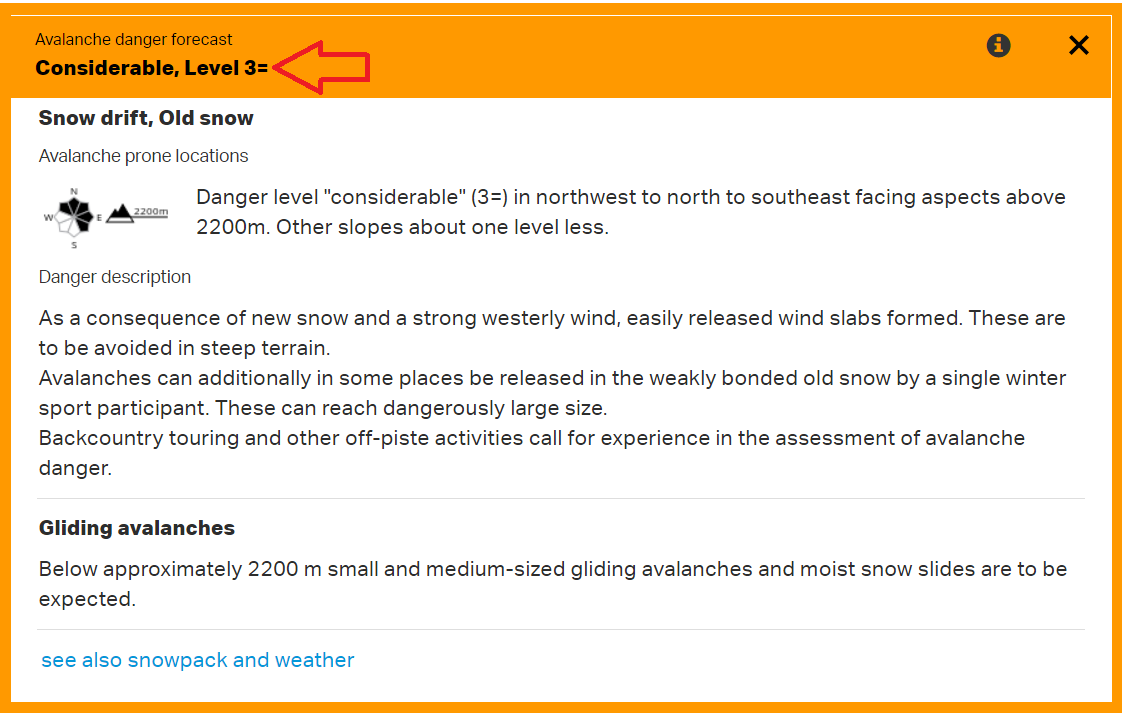You may have noticed some new symbols on the Swiss avalanche bulletin next to the overall risk levels of 1 to 5. The SLF have decided to subdivide the overall risk level to better reflect the danger. At risk 3 snow professionals have long used expression of high or low risk 3 and the SLF are following this idea to indicates whether the danger is more in the lower, middle or in the upper part of the degree of danger. Effectively, each increase in danger level is a square of the risk. The danger levels could be better expressed as: 1, 4, 16, 32, 64. For level 3 the subdivsion is 8, 16, 24 with the new scheme. So a 3+ day could be expected to have 3x the number of avalanche incidents as a 3- day.

From this winter, the SLF is subdividing the danger levels of the avalanche bulletin by adding intermediate levels. The current five danger levels, which describe the avalanche danger on a scale from "low" (level 1) to "very high" (level 5), remain unchanged. They are now supplemented by an indication specifying whether the danger is located rather in the lower (-), the middle (=) or the upper part (+) of the degree of danger, which corresponds better to the continuous evolution of the avalanche danger. This additional indication applies from degree 2 and exclusively for dry snow avalanches. This information was already implicitly contained in the description of the dangers; it is now explicit. The interpretation of the avalanche bulletin is thus simplified.
Why this change? For years, the SLF has been regularly asked to indicate the danger of avalanches more precisely. Degree 3, in particular, represents a very wide range for people who practice snow sports. Avalanche forecasters have also long felt the need to be able to indicate danger more precisely. The introduction of intermediate levels now makes it possible to meet these wishes.
It is not possible to add additional degrees of danger due to the international context. Kurt Winkler, avalanche forecaster, explains: "One of the advantages of the new system is that it takes into account knowledge from psychological research. The human brain can distinguish a maximum of five to seven defined classes. It is therefore always about the degrees of danger for which there are clear definitions. This classification is done by logical - and therefore slow - thinking. But in addition, we are able to easily understand a hierarchy within classes. Such a subdivision can be understood intuitively and therefore quickly."

For the last six winters the Swiss avalanche forecasting service has assigned a subdivision to all danger assessments, but this was not published. In order to establish the relevance of this novelty, this large set of data was subjected to statistical analysis. This clearly showed that the differences between the degree of danger predicted in the avalanche bulletin and the information provided by the field are smaller when the intermediate level is taken into account. Furthermore, a clear relationship with objectively measurable factors of avalanche formation emerged. From one intermediate level to the next, for example, the frequency of thuds and human-triggered avalanches increases, while conversely, the results of stability tests deteriorate. Experience has also shown that this principle also does not apply in case of wet avalanches, no intermediate level is indicated in these situations.
Who are the intermediate levels for and how can they be used properly? Everyone can benefit from this additional information. "If we want to escape the most dangerous situations of a winter, we can for example simply avoid regions where the degree of danger is equal to or greater than 3+ and instead choose a region where the danger is less, or give up going out in the mountains that day," continues Kurt Winkler. But intermediate levels can also be used quantitatively. Thus, the calculation of the avalanche risk on skitourenguru.ch takes these subdivisions into account.